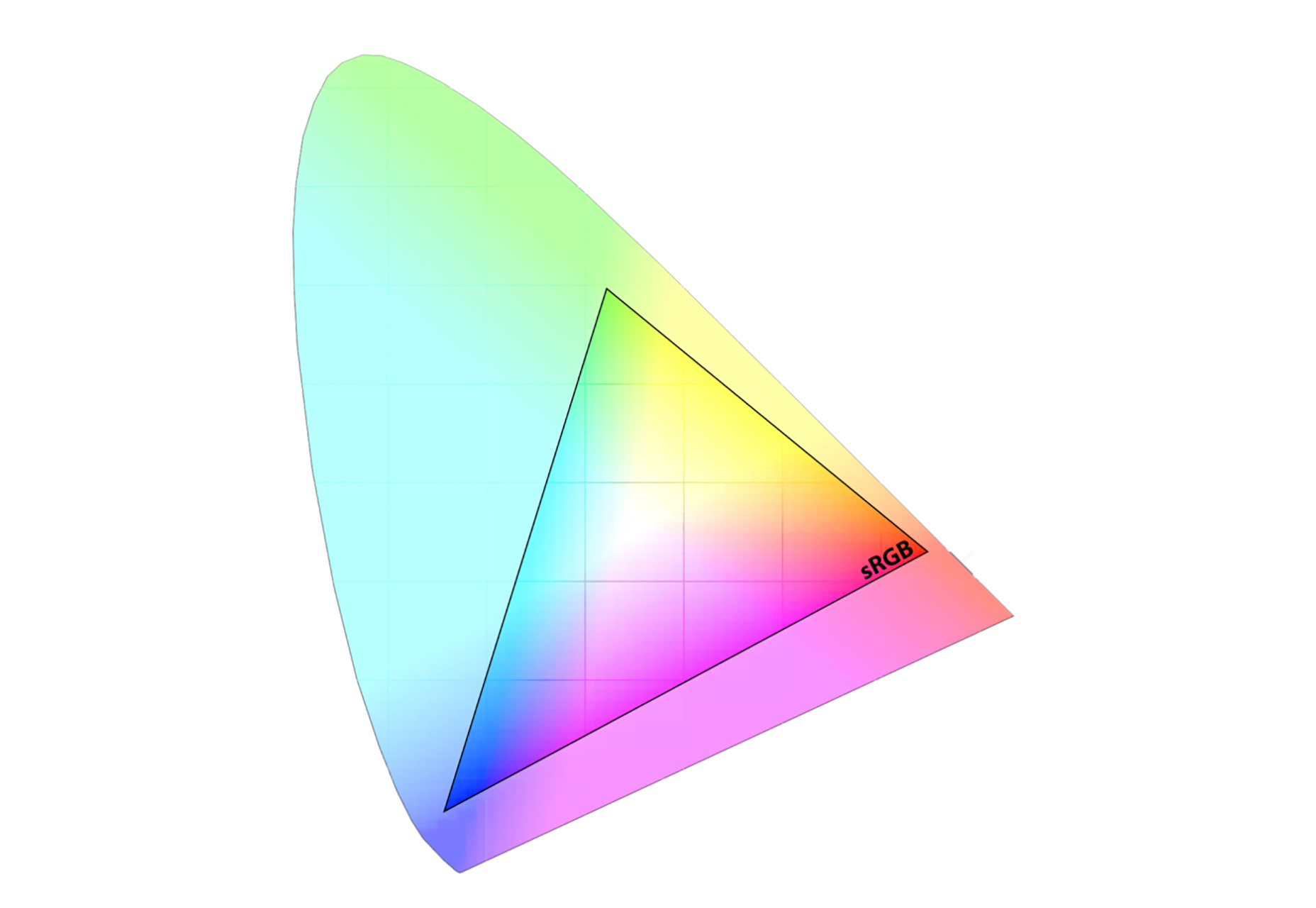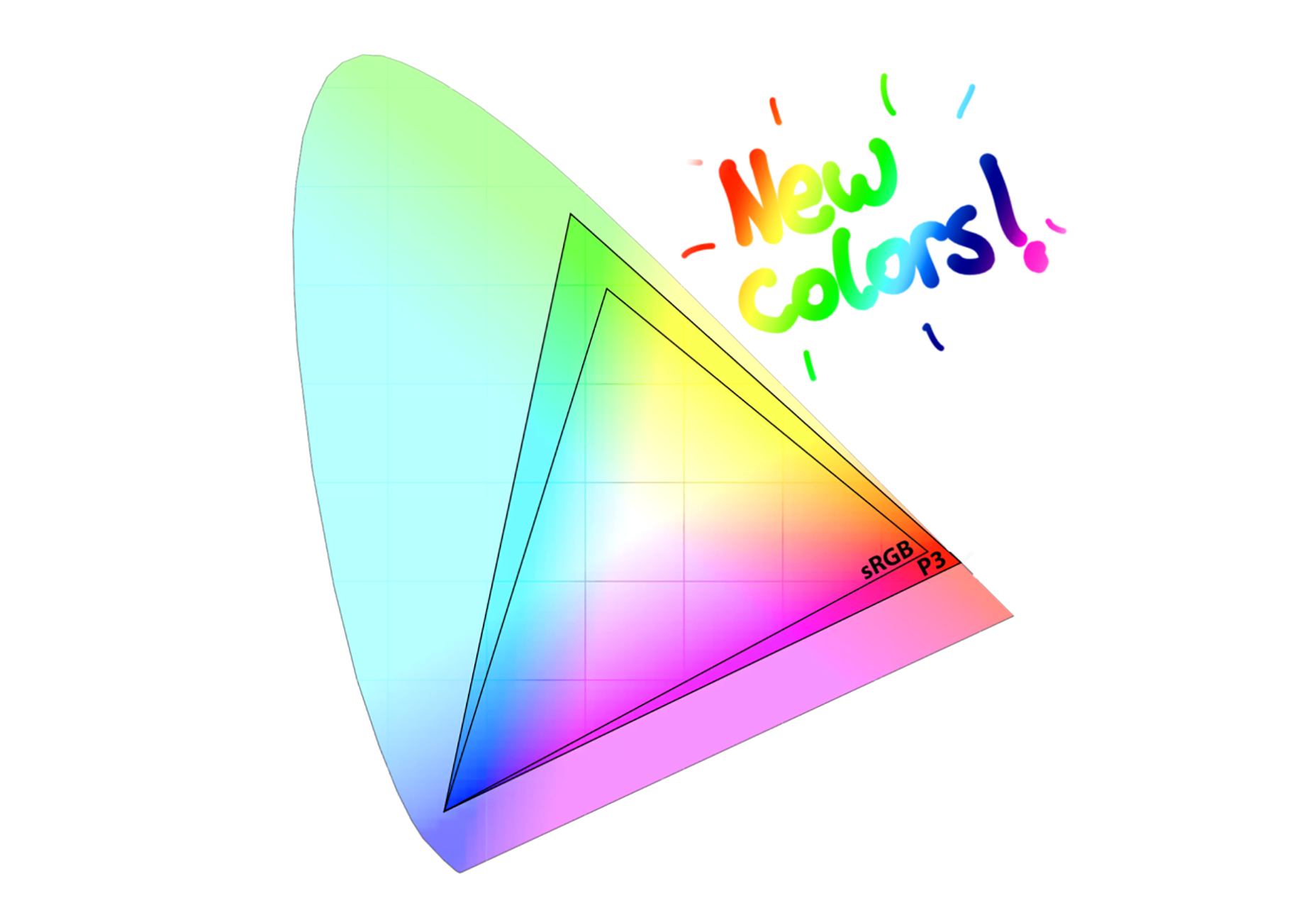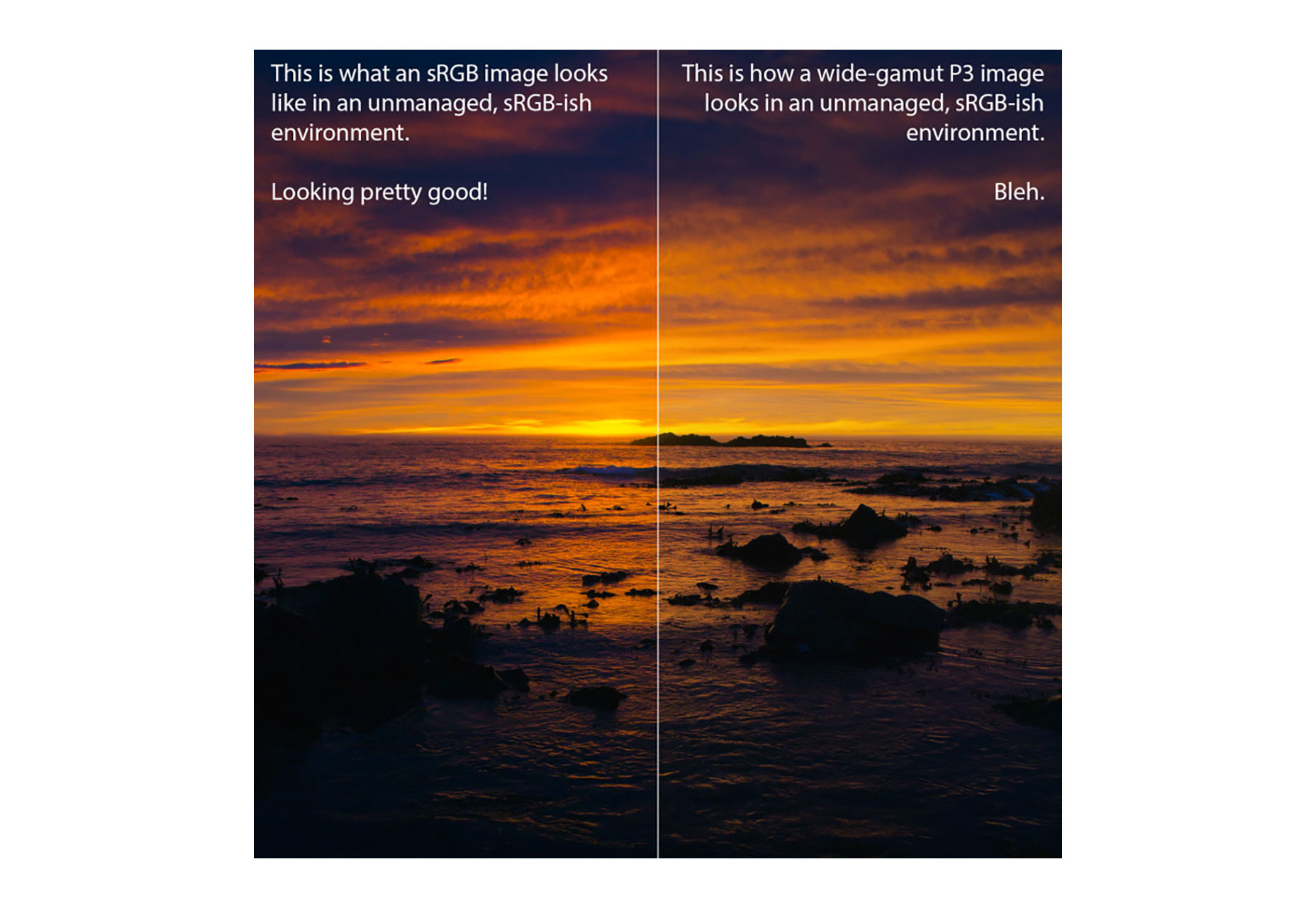This red goes to #FG0000: Wide-Gamut Color with <picture> and Cloudinary

Wide-gamut Screens
For the last 20 years, the display industry has settled on a limited, standard range of colors, called the sRGB gamut. If the lopsided, chopped-off-rainbow-disc below (technical name: the “1931 CIE Chromaticity Diagram”) represents all of the colors that human eyes can see, the sRGB gamut is circumscribed by the little triangle in the middle. The latest-generation of displays can produce colors outside of sRGB’s limited range. These screens expand the triangle of possibilities out, to what’s called the P3 gamut:
The latest-generation of displays can produce colors outside of sRGB’s limited range. These screens expand the triangle of possibilities out, to what’s called the P3 gamut:
 The P3 gamut, compared to sRGB. It’s bigger!
Triangles are one thing and actual photographs are another—for a sense of what this wider range actually looks like in practice, beg, borrow, or steal a wide-gamut display and go check out Craig’s gorgeous example images, or look at this quick example, from yours truly. Basically, if your subject is really saturated (for example: an incandescent sunrise, or bright-green grass) P3 will let your images pop in new and notable ways. But if your image’s palette is more subdued, sRGB already has you covered and you’ll see no visible difference.
So – devices that can display new, more vibrant colors are shipping en masse. How can we take advantage of them, without screwing things up for everybody else?
The P3 gamut, compared to sRGB. It’s bigger!
Triangles are one thing and actual photographs are another—for a sense of what this wider range actually looks like in practice, beg, borrow, or steal a wide-gamut display and go check out Craig’s gorgeous example images, or look at this quick example, from yours truly. Basically, if your subject is really saturated (for example: an incandescent sunrise, or bright-green grass) P3 will let your images pop in new and notable ways. But if your image’s palette is more subdued, sRGB already has you covered and you’ll see no visible difference.
So – devices that can display new, more vibrant colors are shipping en masse. How can we take advantage of them, without screwing things up for everybody else?
Wide-gamut Resources
First, we have to produce files that contain these new colors. Generally, you can do this by making sure that: 1) your camera is capturing– 2) your software is editing– and, crucially, 3) that you’re exporting– in a wide gamut (like P3, Adobe RGB, or Adobe ProPhoto). And don’t forget to embed a color profile. For a detailed tutorial on how to do this with Photoshop, buy Craig’s book! If you’ve got a shiny new iPhone, though, you don’t have to worry about minding your Ps and Qs in obscure preference panes. The iPhone 7 captures, processes, and saves photos in the P3 gamut out-of-the-box.Wide-gamut on the Web
Ok, so let’s say you’ve captured a beautiful sunrise and produced a wide-gamut Jpeg with an embedded profile. Great! How are you going to share that image with the world? Let’s start by marking it up using a single-src <img>: <img src="sunrise-p3.jpg" alt="Oranges and blues" /> In browsers that implement “color management” – browsers that know how to use the image’s embedded profile to map the image’s wide-gamut colors to a device’s particular screen – the sunrise will always look as good as the hardware will allow. It will look good on sRGB-ish screens, and great on wide-gamut displays. But many browsers are not color managed. And in color-unmanaged browsers, the raw color values in our image are painted directly to the screen, without consideration for how the file’s wide profile relates to the display’s limited gamut. This results in a dull image – much worse than if we’d just left well enough alone and exported our image in sRGB: Comparison between a vibrant, sRGB sunrise and a a dull, wide-gamut sunrise on a color-unmanaged display
In color-dumb browsers, wide-gamut images look worse than their narrow-gamut, sRGB counterparts.
What can we do about this sad state of affairs? Unfortunately, there’s no easy way to feature test whether or not a browser is color-managed. But we can ask the browser if a screen’s profile is more sRGB-like or P3-esque, using the brand-new color-gamut media query. If we use this query within a <picture> element, we can make sure that we only send wide-gamut images to wide-gamut screens – and send sRGB images to everybody else:
Comparison between a vibrant, sRGB sunrise and a a dull, wide-gamut sunrise on a color-unmanaged display
In color-dumb browsers, wide-gamut images look worse than their narrow-gamut, sRGB counterparts.
What can we do about this sad state of affairs? Unfortunately, there’s no easy way to feature test whether or not a browser is color-managed. But we can ask the browser if a screen’s profile is more sRGB-like or P3-esque, using the brand-new color-gamut media query. If we use this query within a <picture> element, we can make sure that we only send wide-gamut images to wide-gamut screens – and send sRGB images to everybody else:
<picture> <source media="(color-gamut: p3)" srcset="sunrise-p3.jpg" /> <img src="sunrise-sRGB.jpg" alt="Oranges and blues" /> </picture>That, my friends, is a color-adaptive responsive image. Neat!
Responsive Color with Cloudinary
Make no bones about it, creating responsive image assets is tedious. Whether you’re rendering multiple resolutions, crops, formats, or, now, color gamuts – the task of generating alternate versions of your assets is ripe for automation. Enter Cloudinary. Cloudinary’s color-smarts are still evolving, but today, the service has two key features:- If an uploaded image has a color profile, Cloudinary preserves it.
- Cloudinary can convert any image to sRGB using the cs_srgb transformation.
<picture> <source media="(color-gamut: p3)" srcset="https://res.cloudinary.com/eric-cloudinary/image/upload/sunrise.jpg" /> <img src="https://res.cloudinary.com/eric-cloudinary/image/upload/cs_srgb/sunrise.jpg" alt="Oranges and blues" /> </picture>This pattern allows us to generate a single, wide-gamut resource, and deliver it in a way that looks great for some, and good for everybody. ✨☺️??✨
Ready for Anything
As screens begin to evolve along this new axis – becoming more colorful – it’s gratifying to see the techniques and toolchains built to cope with the Retina-revolution so ready to tackle a new challenge. On the ever-evolving, always-diversifying web, adapting bitmap images to varied browsing contexts is a general problem, and responsive image markup patterns – paired with a centralized, automated image-processing back-end like Cloudinary – are here to solve it, no matter the particulars. So – armed with P3, <picture>, and Cloudinary’s cs_srgb – voyage forth bravely into a wider world of color. [-- This is a sponsored post on behalf of Cloudinary --]WDD Staff
WDD staff are proud to be able to bring you this daily blog about web design and development. If there's something you think we should be talking about let us know @DesignerDepot.
Read Next
3 Essential Design Trends, May 2024
Integrated navigation elements, interactive typography, and digital overprints are three website design trends making…
How to Write World-Beating Web Content
Writing for the web is different from all other formats. We typically do not read to any real depth on the web; we…
By Louise North
20 Best New Websites, April 2024
Welcome to our sites of the month for April. With some websites, the details make all the difference, while in others,…
Exciting New Tools for Designers, April 2024
Welcome to our April tools collection. There are no practical jokes here, just practical gadgets, services, and apps to…
How Web Designers Can Stay Relevant in the Age of AI
The digital landscape is evolving rapidly. With the advent of AI, every sector is witnessing a revolution, including…
By Louise North
14 Top UX Tools for Designers in 2024
User Experience (UX) is one of the most important fields of design, so it should come as no surprise that there are a…
By Simon Sterne
What Negative Effects Does a Bad Website Design Have On My Business?
Consumer expectations for a responsive, immersive, and visually appealing website experience have never been higher. In…
10+ Best Resources & Tools for Web Designers (2024 update)
Is searching for the best web design tools to suit your needs akin to having a recurring bad dream? Does each…
By WDD Staff
3 Essential Design Trends, April 2024
Ready to jump into some amazing new design ideas for Spring? Our roundup has everything from UX to color trends…
How to Plan Your First Successful Website
Planning a new website can be exciting and — if you’re anything like me — a little daunting. Whether you’re an…
By Simon Sterne
15 Best New Fonts, March 2024
Welcome to March’s edition of our roundup of the best new fonts for designers. This month’s compilation includes…
By Ben Moss
LimeWire Developer APIs Herald a New Era of AI Integration
Generative AI is a fascinating technology. Far from the design killer some people feared, it is an empowering and…
By WDD Staff












